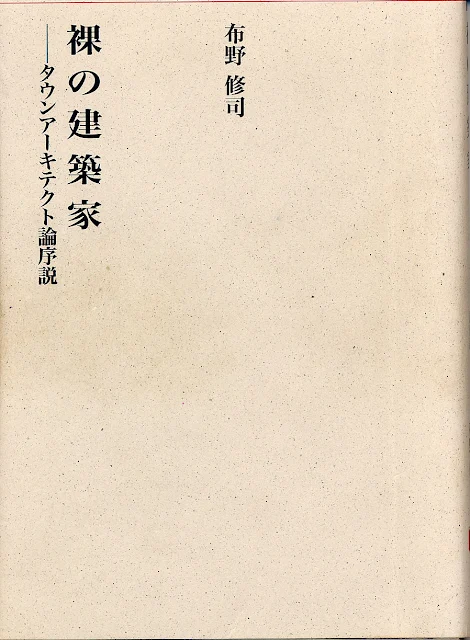Ⅳ タウン・アーキテクトの可能性
第8章 タウン・アーキテクトの仕事
8-1 アーバン・アーキテクト
「アーバン・アーキテクト」という言葉が突然創り出され*1、一人歩きし、その挙げ句に闇に葬り去られてしまった。「アーバン・アーキテクト」という命名に僕は全く関知しないのであるが、その言葉が産み出された背景はよく知っている。というより、その主唱者であるかのように見なされて、インタビューを受けたことがある*2。きっかけは「建築文化・景観問題研究会」*である。建築課長(住宅課長)として県や政令指定市に出向する建設省のスタッフと何人かの「建築家」が、主として「景観問題」を議論する場が(財)建築技術教育普及センター*内につくられ、その座長を務めていたのである。
その主張は、簡単にいうと「豊かな街並みの形成には「建築家」の継続的参加が必要である」ということである。「アーバン・アーキテクト」制と呼ばれる制度の構想は、いかにすぐれた街並みを形成していくか、建築行政として景観形成をどう誘導するか、そのためにどのような仕組みをつくるか、という問題意識がもとになっており、その仕組みに「アーバン・アーキテクト」と仮に呼ぶ「建築家」の参加を位置づけようという構想である。その限りにおいて、「建築界」にそう反対はないと思っていた。
しかし、実際、どう制度化するかとなると多くの問題があった。建築士法が規定する資格制度、建築基準法の建築計画確認制度、さらには地方自治法など既存の制度との関係がまず問題になる。さらに、それに関連する諸団体の利害関係が絡む。新しい制度の制定は、既存のシステムの改編を伴うが故に往々にして多くの軋轢を生むのである。
(財)建築技術教育普及センターによる「アーバン・アーキテクト」制の構想は以下のようであった。
①アーバン・アーキテクトは自己の活動実績を含め必要事項をセンターに登録、センターはアーバン・アーキテクトのデーター・ベースを構築する(センターは登録料を経費に充てる)。
②地方公共団体等が、景観形成やまちづくりに資するために建築の専門家を捜す場合、希望に基づきセンターがデーターから情報を提供する(センターへは情報提供料を納入)。
③アーバン・アーキテクトの関与するまちづくり事業については、建設局所管の助成事業との連携を図る。
この構想ではセンターは人材派遣組織ということになる。また、中央から一方的に地方の仕事に介入するとの印象がある。さらに、「アーバン・アーキテクト」制は、「建築士」の上に新たな資格の制定もしくは新たな確認制度の制定の構想と受けとめられたらしい。(財)建築技術教育普及センターは、「建築士」などの資格試験を実施している機関だからである。そして、その資格の認定を誰が、どういう機関が行うかをめぐって、水面下で熾烈な抗争?があり、さしたる議論もないままに「アーバン・アーキテクト」という言葉は忘れ去られたのである。
a マスター・アーキテクト
「アーバン・アーキテクト」制の構想は、一方で「マスター・アーキテクト」制の導入と受けとめられた。「マスター・アーキテクト」制というのもはっきりしないのであるが、いくつか具体的なイメージがある。
「マスター・アーキテクト」制とは、もともとは、大規模で複合的なプロジェクトのデザイン・コントロール、調整をマスター・アーキテクトに委ねる形をいう。住宅都市整備公団の南大沢団地、あるいは滋賀県立大学のキャンパスの計画において、いずれも内井昭蔵*をマスターアーキテクトとして採用された方式がわかりやすい。また、長野オリンピック村建設におけるケースがある。マスター・アーキテクトがいて、各ブロックを担当する建築家(ブロック・アーキテクト)に指針としてのデザイン・コードを示し、さらに相互調整に責任をもつ。もう少し複雑な組織形態をとったのが幕張副都心○の計画である。委員会システムがとられ、デザイン・コードが決定された上で、各委員がブロック・アーキテクトとして、参加建築家の間を調整するというスタイルである。長野の場合、地元建築家とのJV(ジョイント・ヴェンチャー)が義務づけられている。いずれも、新規に計画されるプロジェクト・ベースのデザイン・コントロールの手法である。
b インスペクター
一方、阪神・淡路大震災が起こって状況が変化した。街づくり、景観行政、景観デザイン以前に、「建築家」の能力が問われたのである。そして、「アーバン・アーキテクト」などより、「インスペクター(検査士)」の方がテーマになった。景観以前に違反建築や既存不適格の建築を糾すのが先決というわけである。建築士制度の問題としては、「構造技術士」の構想がかねてからある。「第三者機関」による検査制度*が差し迫った課題となると、「アーバン・アーキテクト」をめぐる議論は棚上げされてもやむを得ない。
何も法制度としての「アーバン・アーキテクト制」が問題なのではない。現行法制度下においても、その構想を具体化する方策は色々ある。むしろ、「アーバン・アーキテクト制」が全国一律の制度として出来上がった瞬間に別の問題が生ずる可能性がある。なぜなら、問題は、各地域で、各自治体で、それぞれ固有の、個性豊かな街並みをどうつくりあげるかであって、そのためにどんな仕組みが必要かなのである。仕組みそのものも個性的で多様であることがおそらく前提となる。本書で「タウン・アーキテクト」(あるいは「シティ・アーキテクト」「コミュニティ・アーキテクト」)という言葉を用いるのは、「アーバン・アーキテクト制」という制度の構想と区別するためである。
c 環境デザイナー登録制度
理念と現実のギャップは大きい。「アーバン・アーキテクト」制は基本的には建設省をベースにした発想であった。いきなり制度を考えるより、具体的な実践を展開するのが早い。本来「アーバン・アーキテクト」は、地方自治体ベースの発想である。だから「タウン・アーキテクト」「シティー・アーキテクト」である。「ヴィレッジ・アーキテクト」でもいい。ことは、日本の地方自治のあり方の根幹に関わる。
「アーバン・アーキテクト」は、そもそもどういう業務を果たすべきか、構想は以下のようにいくつかあった。
①公共団体等のまちづくりのうち、街区の景観デザイン、デザインコードの作成、地区施設等のデザインを担当する。
業務の性格:公共建築の設計
業務内容:実態調査、基本設計
業務形態:調査業務委託中心、設計業務委託
②公共団体等のつくる公共建築物の設計について、まちなみ等地域特性への配慮、地域住民の参加等に基づき実施する。地域に根づき長期間にわたり複数の施設を設計していくことが期待される。
業務の性格:地域ベースの建築家
業務内容:実態調査、基本設計、実施設計
業務形態:設計業務委託
③公共団体のつくる公共建築物等について、まちなみ等地域の特性に配慮した基本方針を策定し、これに基づき設計を行う建築を選定し、指導し、助言し、評価する。
業務の性格:プロデューサー、ディレクター
業務内容:調査業務委託、審査業務、相談業務
業務形態:調査業務委託、顧問業務
構想として「アーバン・アーキテクト」は全てに関わる。しかし、①~③のどの業務にウエイトを置くかでその方向は異なる。根本問題は、誰が業務としてどのような報酬を受けるのかである。つまり、義務と権利、責任と報酬の問題である。
まず、本来自治体の仕事とそれを業務として受託して行う仕事が区別されるべきである。「アーバン・アーキテクト」の仕事は自治体の仕事とはいささか次元が異なるのである。
中央がモデルにならないから、県レヴェルで仕組みを考えた。
島根県における「環境デザイナー支援事業」*がそうである(●)。
まず、環境デザイン検討委員会なるものが組織された。いわゆる学識経験者からなる。要するに、委員会メンバーは業務とは関わらないのが前提である。一方、環境デザイナーの登録が行われ、これまでの実績、仕事についての希望などが一定のフォーマットによってデータ・ベース化された。今のところ県内に限られているけれど県外にも拡大される予定である。県外については、公開コンペなどのチャンスに応募者を登録していくやり方を考えているが、これまでの県内での実績をもとに登録を拡大していく方法もある。各県で独自の登録制が工夫されればいい。ひとつの問題は、各自治体における指名業者登録との兼ね合いである。また、既存の建築事務所組合など受注組織との関係である。プロジェクトの性格によって、ケース・バイ・ケースのやり方がしばらく必要である。
具体的な公共事業について、委員会は、様々な形でそのデザインについて意見を述べるが、まずデザイナーの選定について、その方式を提案する。そして、それぞれの方式について、デザイナー選定委員会あるいは建設委員会を組織する。環境デザイン検討委員会とデザイナー選定委員会が区別されるのがミソである。
最初のケースは、宍道湖大橋の拡幅に伴う橋梁のデザインであった。登録名簿も未完であり、時間の余裕がなかったことから、環境デザイン検討委員会そのものが環境デザイナー選定に当たった。何人かの候補者から実績資料の提出を受け、一人のデザイナーが選定され提案を作成した。既に構造計算も終わり、実施設計が完了していたにも関わらず、当局は柔軟に対応した。選定されたデザイナーには、橋梁のデザインのみならず、橋詰めの公園のデザインにも関わってもらい、一体としてデザインするかたちを採ることができた。一歩前進である。
2番目の事例は警察署の設計である。情報公開できない内容があるとか県の営繕課の仕事との関係で理想的にはいかなかったが、一応、検討委員会が審査委員会を組織する本来のかたちをつくることができた。しばらくは試行錯誤を続けていく必要がある。
8-2 景観デザイン
a ランドシャフト・・・景観あるいは風景
なぜ「タウン・アーキテクト」なり「シティ・アーキテクト」構想なのか。ひとつのきっかけはこの間の景観行政の展開である。
景観(風景)条例を制定する自治体はおよそ二〇〇に登る。今後も多くの自治体で景観条例の制定が続くことが予想される。しかし、景観条例とは一体何なのか。あるいは、それ以前に、景観とは一体何なのか。
景観あるいは風景、英語でランドスケープlandscapeあるいはドイツ語でランドシャフトlandshaftといった概念をめぐっては多くの議論が必要である。しかし、ここでは概念規定をめぐる基本を確認するに留めよう。
まず確認すべきは、景観あるいは風景がランド、すなわち土地に結びついた概念であるということである。景観あるいは風景は土地に固有なものである。クラウドスケープ(雲景)、シースケープ(海景)という場合も同じであろう。同じような景観はあっても、同じ景観はないのである。景観条例が地域の独自な景観のあり方をうたうのは当然である。
景観と風景を分ける主張がある。「西欧の景観、日本の風景」*という時、景観は客観的な土地の姿、風景は主観によって受けとめられた土地の姿という区別が前提のようだ。景観が「われわれが見るWe see」、風景は「私が見るI see」という区別もある。ここで確認すべきは、景観にしろ、風景にしろ、共有化された土地の姿が問題となることだ。K.リンチの『都市のイメージ』*がわかりやすい。土地に関する「集合イメージ」が問題なのである。景観条例が成立するのは、景観が地域のアイデンティティに関わる共有されたものだからである。
さらに確認すべきは、景観あるいは風景は、視覚的な土地の姿のみに関わるわけではない、ということだ 。景観は確かに観ることに関わる。しかし、サウンドスケープ(音景観)という概念もある。例えば、水や風を感じるのは視覚のみならず、聴覚もあり、触覚もある。また、臭いを嗅いだり、舐めてみたりということもある。要するに、景観あるいは風景は、視覚のみならず、五感の全てで関じる土地の姿に関わると規定しておいた方がいい。
b 景観のダイナミズム
景観あるいは風景をめぐっては、まだまだ考えておくことがある。ひとつは景観のダイナミズムであり、また、そのレヴェルである。さらに、そのスケールである。
景観は変化するものである。自然景観が四季によって異なるように、市街地景観も人々の営みによって日々姿を変える。新たな建物が建てられたり、既存の建物が建てられたり、長い間には市街地景観も変化する。この間あまりに急速に変化が起こったが故に、景観が意識されるようになったのであり、その前提は景観は変わらないというのではなく、変わるものだということである。
あるいは、変わらないものと変わるものを分けて考えておく必要がある。自然景観はそう変わらないものであり、市街地景観のような人為的空間は変わるというのがわかりやすいかもしれない。しかし、大きく自然景観を変えてきたのが近代であり、自然破壊の事例は枚挙に暇がない。また、市街地景観であれ、自然景観を傷つけることによって、あるいは自然景観の中で成り立つのだから、その区別は簡単ではない。ここで言いたいのは景観を固定的に考えるのは不自然だということである。すなわち、景観はダイナミックに変化するものであり、保存(凍結保存)というのは本来不自然だという確認である。問題は、従って、変化の過程であり、その秩序である。
景観を誰がどこで享受するものか、という問題がある。視覚的景観について言えば、どの場所で見る景観かという「視点場」の問題がある。全ての住民による全ての場所の景観が問題であることは言うまでもないが、景観という場合、上述したように共有され景観が問題となる。
都市全体の景観、その都市を象徴する視点場からの景観もあれば、地区(コミュニティ)単位で共有された佇まいもある。また、大きな通りに沿ったパースペクティブな景観もある。大景観、中景観、小景観といった区別がなされるのは、むしろ当然である。
ある土地の姿という時、そもそもその土地がどうアイデンティファイされるかが問題である。景観という観点において、地域はどう設定されるかである。自然景観の特性によって、ある土地なり、地域があるまとまりをもって設定される場合はわかりやすい。かってはそうであった。しかし、都市が一定規模を超えると、また、全国の都市が同じような景観を呈し出すと、そのまとまりが極めて曖昧となる。そこで、景観(土地、地域)のまとまりを地区毎に区別する必要がある。ある街の景観について、ある地区の景観やイメージのみで都市全体を議論するのは地区毎のアイデンティティを無視することにつなるのである。
c 景観マニュアル
景観あるいは風景という概念にたどたどしく拘ったのは、正直に言って、景観というものがわからないからである。結局、以上のように、極めて、全体的な概念として考えるしかない、と思えるからである。ストレートに言えば、景観は高さや色だけではない、ということである。高さや色に象徴されるものの背後に、以上のような何か全体的なものが問われているということである。
そこで景観条例(●事例)である。景観条例とは一体何か。
よく言われるように、景観条例は、どの自治体のものもそう変わりはない。基本的な方針をうたうだけだから、そう変わりはないのも不思議はないといえる。しかし、以上で確認したような、地域(地区)毎の固有性、景観のダイナミズム、景観のレヴェルやスケールの区別についての基本理念がうたわれるわけではない。「景観が大事である」というけれど、実は何が大事なのかはわからない。問題は、具体的な規定、マニュアルの次元で明瞭になる。景観マニュアルもまた全国どこの自治体でも似たりよったりなのである。
自然景観を守れ、というのであればある範囲でその施策は共有できる。しかし、どういう建物が相応しいかについてはそう簡単ではない。
よく問題になるのは、国立公園とか国定公園における形態規制である。国立公園内では、勾配屋根でないといけないという。また、曲線を使ってはいけないという。さらに、原色をつかってはいけないという。なぜそうなるのか。風致地区とか、美観地区でも同じである。ステレオタイプ化されたマニュアルが用意されており、建築確認制度とは別に許認可にあたって「建築家」は規制を受ける。
「周囲の景観にあった」デザインがいい、という。それが「勾配屋根」であり、「曲線は駄目」であり、「原色は駄目」となる。恐ろしく短絡的思考ではないか。どうも、景観行政といってもそのレヴェルの話に留まり続けているようなのである。
「陸屋根」が駄目というのであれば、近代建築は一切駄目ということか。「帝冠様式」の時代を思い出す。木造の架構であれば勾配屋根となるのはごく自然である。しかし、鉄筋コンクリート造の建物を全て勾配屋根にしろとは不自然であり、行きすぎればファッショだ。ヴァナキュラーな建築にだって陸屋根はある。やはり地域毎、地区毎に考えるべきではないか。何で曲線は駄目か。自然界は曲線に満ちており、直線の方が不自然だ。色ほど文化的なものはない。日本人は生成(きな)りの色を好む、といわれる。赤、青、黄色の原色は駄目、という。しかし、お稲荷さんの赤(朱)はどうか。緑に映えて綺麗だ、という人たちは多いのではないか。神社仏閣でも、多彩な色を日本でも使ってきたのである。
何を根拠に形態や色彩を規制できるのか。以上で、まず言いたいのは、一律の規定、マニュアルなどありえないのではないかということである。具体的な判断は個々の場所に即して議論するしかないのではないか。そこで必要とされるのが、「タウン・アーキテクト」のセンスなのである。
d 景観条例・・・法的根拠
しかし、問題は別の次元ですぐ明らかになる。仮に、何となく、ある地域(地区)について、共有化された将来イメージが確認されたとしよう。その確認の手続きこそが大問題である。さらに、景観条例制定あるいはそれに基づく景観形成地区といった地域(地区)指定の前提に関わる大問題であるが、それ以前に、景観条例というものが何ら法的根拠をもたない、というさらに大きな問題がある。
いくつか具体例を挙げよう(●資料)。
ある県の景観審議会に相次いで「物件」(作品)がかかった。ひとつは七五メートルの高層ビル。京都が六〇メートルで大騒ぎ、ということを考えると、地方都市(京都、金沢と並んで三古都を宣伝文句にうたう)にはいささか不釣り合いだ。しかし、この作品は景観形成地域からほんのわずかだけれど外れていた。もうひとつは当初九階建てで計画されたマンション。これは景観形成地域内であった。このふたつの建物は湖の河口の橋を挟んで南北に位置し、いずれも、この上ない景観を享受する位置に立地する。
結果だけ言えば、ふたつの建物はいずれも既に竣工している。
景観審議会は、公開であった。極めて進んでいる県といっていい。いずれのケースも二度も設計者・施工者に対する公開ヒヤリングを行った。七五メートルの高層ビルの場合、あまりにヴォリュームが大きく、交通問題なども予想されることから、代替地を探すのはどうか、というのがオールタナティブであったが、問題にならなかった。建築基準法上の要件を満たしておれば確認を下さざるを得ない。
面白かったのは、設計者が「周辺環境に配慮すべし」という景観条例は充分遵守した、と繰り返したことである。ヴォリュームそのものがスケール・アウトであればどうしようもない。どうせなら、日本のどこにもない、強烈なランドマークになる「目立つ」デザインの方がいいのではないか、というのが僕の挑発であったけれど、噛み合わない。景観とは一体何なのか。
マンションの方は、明らかに景観条例違反であった。県がその土地を買い上げて公園化すべしというのが、委員の大半の意見であったが、うまくいかなかった。不思議なことに、階数を切り下げるということで決着がはかられた。それは筋が違うと、景観審議会としては、官報に施主者名を公表することになった。氏名公表が今のところ最大の罰則である。
施主側にも言い分があった。ほぼ同じ位置にたつのに、高層ビルはOKで当該マンションは駄目だ、というのは納得できない。それに、既存の多くのビルが既に景観を壊しているのではないか、という主張である。
かくして、この県の景観条例は、その効果が最も期待された「物件」の竣工によって骨抜きにされたのであった。
一体どうすればいいのか。どうせ法的根拠がないのであれば、もっと実効ある仕組みが考えられるべきではないか。
8-3 タウン・アーキテクトの原型
a 建築主事
建築確認行政に関わるのは建築主事*である。全国の土木事務所、特定行政庁に、約一七〇〇名の建築主事*がいる。
建築行政といっても、確認行政に限定されるわけではない。都市計画に関わる施策の範囲は多部署にわたる。しかし、ここでは建築主事に限定して考えよう。「タウンアーキテクト」に一番近い存在は建築主事なのである。
そもそも、「アーバン・アーキテクト」の構想は、建築指導行政のあり方についての反省から発想されたのである。
建築確認行政は基本的にはコントロール行政であった。かって、警察がその仕事としていたように、基本は取り締まり行政である。建築基準法に基づいて、確認申請の書類を法に照らしてチェックするのが建築主事の仕事である。しかし、そうした建築確認行政が豊かな都市景観の創出に寄与してきたのか、というとそうは言えない。「アーバン・アーキテクト」構想の出発点はここである。
建築主事が「タウン・アーキテクト」になればいいのではないか、これが僕の答えであった。全国で二千人程度の、あるいは全市町村三六〇〇人程度のすぐれた「タウン・アーキテクト」(「シティ・アーキテクト」)がいて、デザイン指導すれば、相当町並みは違ってくるのではないか。それこそが建築指導ではないか。
実は、ヒントがあった。デザインにまで口を出す建築主事さんが実際いたのである。建築主事は、街のことをよく知っている。法律制度にも通じている。建築に理解のある、建築を愛する建築主事さんこそ「タウン・アーキテクト」に相応しいのである。
しかし、そうはいかないという。デザイン指導に法的根拠がないということもあるが、そもそも、人材がいないという。一七〇〇人の建築主事さんは、法律や制度には強いかもしれないけれど、どちらかというとデザインには弱いという。
もしそうだとするなら、「建築家」が手伝う形を考えればいいのではないか。第二の答えである。その形は様々に考えられる。また、必ずしも一人の「建築家」を想定する必要はない。デザイン・コミッティーのような委員会システムでもいい。
問題は権限と報酬である。
b デザイン・コーディネーター
ある駅前のケース(●島根県出雲市)。突然知事が駅舎のデザインを発表する。神社の形式を模した切妻の屋根だ。一部市民が異を唱えた。しかし、それを議論する場所がない。鉄道線路が高架になり、JRは駅舎のデザインを独自に行う。相互を調整する部署がない。隣地に市の土地がある。市は「地域交流センター」を計画中だ。駅舎とどうマッチさせるか。
こうしたケースは、日本中にある。
景観条例は、周囲との調和をうたうけれど、そもそも、個別の建築活動を調整する仕組みが自治体の内部にない。繰り返し指摘される縦割り行政の弊害である。
問題は、建築主事の問題を超える。都市計画行政と建築行政をつなぐそもそもの仕組みがないのである。
公共建築の建設を考えてみても、下手をするとバラバラである。学校、美術館、体育館は教育委員会。物産館は商工部。発注者が自治体の中でも異なっている。営繕部が統括すればいいけれど、必ずしも権限を与えられているとは限らない。街がバラバラになるのは、バラバラの仕組みの上に建築行政、都市計画行政が展開されているからである。
公共建築の設計については自治体内部に営繕部署がある。しかし、各自治体の営繕部もまた必ずしも一貫した仕事を展開する状況にない。ほとんど外部委託する場合も少なくないのである。
c コミッショナー・システム
「アートポリス」(●)「クリエイティブ・タウン・岡山(CTO)」(●)「富山町の顔づくりプロジェクト」(●)など、この間、「建築界」で注目を集めた試みは、強力なリーダーシップをもった首長によるものであった。
一定規模以下の市町村では、都市計画の全体を統合する役割は首長に期待できる。「タウン・アーキテクト」としての首長である。建築市長あるいは建築副市長の制度をもつ市がドイツにはある。
あるいは建築好きの首長のブレインに「建築家」がつくケースが考えられる。コミッショナー・システムである。
しかし、いずれも問題がある。首長は任期に縛られる。首長が替わることにおいて、施策の継続性が担保されないことが多いのである。公共建築の設計施工が建設業界の利権に結びついており、首長の交替が支持層の交替に結びつくのである。
特定の「建築家」によるコミッショナー・システムも同様の問題をもつ。基本的に「建築界」のボス支配に結びつく可能性をもつからである。コミッショナーは余程の見識をもつ「建築家」でなければ、システムはうまく機能しない。
公共建築の設計については、「設計者選定委員会」のような委員会システムも考えられる。実際、様々な自治体で、そうした委員会がつくられている。いずれにせよ問題は、公平、公開、公正の原理がきちんと機能しているかどうかである。
しかし、それ以前に「タウン・アーキテクト」が関わるのは公共建築の設計のみではない。
d シュタット・アルヒテクト(●)
ドイツの「シュタットアルヒテクト」制も、相当多様なようだ。また、必ずしも制度化されているわけではない。さらに、思ったほど権限もないらしい*3。
ただ、法体系が違う。都市計画の上位計画権は市町村にあるのである。憲法に明確にうたわれている。市町村の「建築法」があって、その下に州の「建築法」がある。そして、その下に「記念物保護法」がある。
また、様々なスケールの計画図書が用意されているのも違う。都市開発計画(1:20,000)、土地利用計画(1:10,000)、まちづくり基本計画(1:2,000)、地区詳細計画(1:1,000)。この地区詳細計画が法的拘束力をもっていることはよく知られている。
シュタット・アルヒテクトに仕事を依頼するのは市町村である。議会が何人かの「建築家」から選定する場合もあれば、市長の知り合いに頼む場合もある。しかし、ほとんどの場合、都市計画局の依頼だという。その場合、コンサルタントといっていいのではないか。日本でもそう変わりはない。
もちろん、いずれの場合も厳格な中立性が求められる。西欧における公共性の概念の歴史の厚みを思い起こしておく必要がある。
計画書の作成にはしかるべき報酬が払われる。個々の指導については、費やした時間に応じて報酬を請求する。仕事の内容によって報酬の基準が定められている。指導内容は記録に残すのが原則である。報酬などがまだ曖昧であるにせよ、このあたり、日本の自治体でも試みられ始めた「コンサルタント派遣」の仕組みとそう遠くはないのではないか。
再開発事業の場合、シュタット・アルヒテクトの報酬は事業費の中でまかなわれる。あくまでも、第三者として、中立的判断を行うのが原則である。一企業、一事業舎の利益を考えてはならない。シュタット・アルヒテクトは、その都市で民間の仕事を行うのは原則として控える必要がある。実際には、仕事を行うことはもちろんある。
e コンサルタント・・・NPO(ノン・プロフィット・オーガニゼーション)*●
もちろん、シュタットアルヒテクトについてはもっと研究する必要がある。また、他の国や地域についても情報が欲しい。しかし、それぞれの地域で、独自の仕組みを考え出すのが本来である。それが本来景観に迫る道である。
上で少しだけ覗いたように、様々な仕組みの萌芽はある。また、既存の仕組みが有効に機能すればいい、ということもある。「建築審議会」にしろ、「景観審議会」にしろ、「都市計画審議会」にしろ、本来、「タウンアーキテクト」としての役割をもっている筈である。しかし、審議会システムが単に形式的な手続き機関に堕しているのであれば、別の仕組みを考える必要がある。
「まちづくり協議会」方式も、「コンサルタント派遣」制度もそれぞれに可能性をもっている。阪神・淡路大震災後の復興まちづくり運動にその萌芽がある。「タウンアーキテクト」の嘱託制度もすぐやろうと思えば出来る。NPOのまちづくりの仕組みへの位置づけも一般に認識されつつある。
一方、コミュニティ自体から仕事を受ける形もあってもいい。コミュニティ・ビジネスの成立可能性も模索されるが、果たして日本ではどうか。
8-4 「タウンアーキテクト」の仕事
タウン・アーキテクトの具体的な像を描いてみよう。すぐさまできることは少なくないのである。
a 情報公開
建築界に限らず日本社会のあらゆるレヴェルで情報公開(ディスクローズ)が求められている。とりわけ、中央官庁をはじめ地方自治体など行政当局の情報開示は時代の流れである。市民に対して、公平、公正であることを原則とするのであれば、情報公開はその前提とならなければならない。
まず、最初の指針は情報公開である。
既存のまちづくりの仕組みにおいても情報公開はすぐさま出来るはずである。都市計画審議会、建築審議会、景観審議会といった審議会システムも公開にすることによって形式的、手続的ではない実質的なものとなる可能性がある。実際、公開されている「景観審議会」もあるのである。まちの景観全体について責任をもつ、少なくとも議論を行って指針を提示する「景観審議会」の会長は、タウン・アーキテクトとして位置づけられていいだろう。景観審議会は、本来、タウン・デザイン・コミッティーとしての役割を持っているのである。
景観賞●などまちづくりに関わる懸賞制度の審査会も公開でいい。まちづくりに関わる議論を公開することによって、ひとつには、まちづくりの方向をめぐって、また、まちのアイデンティティをめぐって、ある共通の理解を育む機会が得られる。行政当局の位置づけとしては、ひとつの啓発活動である。また、行政内容についての説明責任を果たすことにもなる。
b コンペ・・・公開ヒヤリング方式
公共建築の設計競技の審査におけるヒヤリングも原則公開としたい。行政側としてはほとんど手間はかからない。公開ヒヤリングを行う場所の設定さえすればいいのである。公開ヒヤリングについては、島根県でいくつか経験がある。「加茂町文化センター」●「悠々故郷会館(川本町)」●「出雲市地域交流センター」●「鹿島町体育館」(●)などである。
設計競技については、その競技方式をめぐって多くの議論がある。設計料入札が未だに行われつつある現状は、改革すべき多くの問題を抱えていると言わなければならない。しかし、まちのアイデンティティ形成という観点から、公共建築の設計者選定は考えられるべきである。
特命、指名、公開、あるいはプロポーザル方式、二段階方式といった設計者の選定方式は多様であっていい。ただ、設計料の入札によってその金額の多寡によって設計者を決めるというのは言語同断である。設計の質は設計料によって決して担保されないのである。
特命指名だから悪いということではない。他の設計者に代え難い能力をもっているとその設計者が認定できれば特命でも差し支えはないのである。問題は誰がどこで認定するかである。一般的には、特命の発注の決定が非公開で行われることに問題がある。また、通常、設計者の決定を行うのは首長であり、議会の承認を得る。議会において特命の根拠が説明できなくて、形の上だけで指名競技が行われるのが疑似コンペである。
いずれの方式をとるにせよ、全ての設計者選定のヒヤリングを公開とする。これで随分すっきりする。具体的に、指名設計競技の場合を例にとって説明しよう。
何人かの建築家がある公共建築の指名設計競技に指名されたとしよう。この場合、要求する提案内容は様々であってよい。いわゆるプロポーザル方式も含める。ただ、提案内容ではなく、建築家を選ぶ、あるいは組織体を選ぶという形のプロポーザル方式はとらない。あくまでも具体的な土地について、具体的な建物についての提案があって初めて設計者が選定できるというのが前提である。プロポーザル方式というのは人あるいは組織を選ぶのだという主張があるけれど、既往の実績の評価で設計者を選定するのであれば設計競技は必要ない。建築家にとって設計競技への参加が多大な労力を要することと指名料など設計競技にコストをかけたくないという行政の意向でプロポーザル方式が推奨されるが、全く間違いである。全ての公共建築はじっくりと時間とお金ををかけて練られるべきなのである。
提案内容のフォーマットについては様々でいいが、後述するように、公開ヒヤリングが一般市民にも開かれたものであることを前提とするとき、専門の建築家だけでなくわかりやすいプレゼンテーションが求められるべきである。「A3」数枚程度でも提案内容は表現できる。どんな設計競技においても、設計競技への参加者は自らの提案内容をわかりやすく提示することは当然である。
さて、数名から一〇名ぐらいまでの指名設計競技参加者から提案がなされると、通常、ヒヤリングというのが行われる。ヒヤリングを行わないケースもあるけれど、その場合、提出物は相当詳細なものが必要となる。提出物を簡素にするプロポーザル方式による場合、ヒヤリングが原則である。公開設計競技の場合や指名設計競技でも二段階で行われる場合は、一段階目での書類選考はありうる。しかし、最終決定の際にはヒヤリングを前提としたい。審査員の能力の問題とも関連するけれど、提案の意図を直接質疑応答することによって、決定のための正確な情報を確認することが必要だからである。
ヒヤリングは二〇分から三〇分程度、密室で順次個別に行われるのが通常である。これを公開で全指名競技参加者が同席した上で行おうというのが公開ヒヤリング方式である。時間の関係で数名程度の参加が基本となる。
審査委員会の委員長が司会を務める。まず、各提案者が提案内容を二〇分程度で説明する。二~三名の補助説明者を認める場合がある。その後、質疑応答を審査委員を含めて行う。一種のシンポジウム、パネル・ディスカッションの形式である。その意義は以下の通りである。
①住民の地域における生活に密接に関わる公共建築がどのようであるべきか様々な角度から議論する場となる。まちづくりのイヴェントとして位置づけることもできる。
②建築家にとって、自らの提案内容を審査委員のみならず、住民に直接アピールする場となる。まず、他の提案者の提案との差異を強調する必要がある。一方、専門以外の住民、審査員にもわかりやすく説明する必要がある。建築家には負担が大きいが、自己訓練の場でもある。一般の人々に建築の楽しさを理解してもらう絶好の機会となる。
③審査員にとって、同じテーマについては共通に聞くことができ、比較できるメリットがあり、時間の節約にもなる。一方、質問の内容は、審査員の関心、判断根拠を提案者、住民に示す機会となる。審査員の見識もオープンに問われるのである。
本審査は原則非公開でいい。公開で決定することももちろん行われていいけれど、特に建築専門以外の審査員の自由な意見が出にくいことがある。住民投票によって決めることを主張する向きもあるけれど、町並み形成に関わる判断はそれなりの専門的知見とセンスが必要である。また、用地決定などで政治的に対立がある場合、提案内容の質とは別の要素が介入する恐れがある。住民相互が十分に議論する場が保証される場合は住民投票ということも考えられるけれど現状では難しい。例えば、京都の「ポン・デ・ザール(三.五条大橋)」*建設問題で、都市計画審議会の案の閲覧公開に対する意見書は地元住民を中心に賛成多数であったけれど、有識者がマスコミをベースに反対運動を展開するというように、議論の場がない。住民投票制度など、きちんとした決定の仕組みについて情報が周知徹底していることが前提となる。
本審査は非公開としても、可能な限り詳細な報告書がつくられるのが鉄則である。基本的には公開が精神であるということである。何度かの投票を行った場合、審査員がそれぞれどう投票したかは公開されたかは記録され、講評されるべきである。そうすることにおいて審査員も評価され、その役割も果たすことができるのである。
しかし、まだまだ現実は厳しい。以下のような事例もある。
「鹿島町立体育館公開コンペ」「建築専門委員 結果に不満」「町側委員に押し切られた」「運営方法に問題 在り方に疑問の声」という見出しが山陰中央新報の一面を飾った(1996年8月9日)。リード文には、「決定した島根県鹿島町の町立総合体育館の設計案をめぐって、審査した建築専門委員がそろって「町側委員に押し切られた」とし、審査結果に不満を評している。決定案は町側委員が強く支持、建築専門委員は「管理しやすい以外、何の評価もない。他案とのレベルの差は歴然」と主張したが、聞き入れられなかった。」
建築専門委員のひとりが筆者である。審査委員長を務めた。審査については、報告書に述べる通りである。審査委員長として報告書以外に言うべきことはない。
ただ、冒頭のような記事が載ることになったのは、報告書の以下のような付記が公開されなかったからである(現在では公開されている)。
「付記(審査委員長の個人的見解):審査内容、経過についての報告は上記する通りである。審査が慎重かつ公正に行われたことはいうまでもない。しかし、審査結果は、委員長個人の評価判断とは異なったものとなった。審査結果と個人的評価の違いを説明することは、設計競技への参加者、公開ヒヤリングへの参加者、また町民への委員長としての責務と考えて以下に付記する次第である。
選定された案は、コンパクトにまとめられていること、従って管理がしやすいこと、また、メンテナンスにかかる費用等が他案に比べてかからない(と思われる)こと等、専ら、管理者側の評価を重視して選定されたものであって、他の点についてはとりたてて見るべきものがない。他案にはるかにすぐれた提案が多かったことは、審査評に示す通りである。最終的には、「夢を取る」か「無難な案」を取るかが争点となったが、長時間の議論の末、町側委員、町長以下事務当局の意向および能力として、選定案以外を受け入れることができない、と判断して多数決に従うことにしたのが経緯である。
選定案は、以下のような欠点がある。実施に当たっては、可能な限り良い施設となるよう、選定された設計者は、当局、町民と協力し合って努力されたい。・・・(以下、箇条書きの要望事項)・・・以上再度慎重な検討をされたい。」
こう書かざるを得ない案を選ぶ羽目に陥った不徳を恥じるばかりである。そもそも審査委員構成が問題であった。助役、教育長、議長と専門委員2人の構成である。町側委員に建築関係者を入れるように要請したのであるが、「小さな町で建築の専門家はいない、県庁OBの技術者を嘱託として(投票権無し)事務局につけるから」ということであった。町はじめてのコンペであり、しかも公開ヒヤリングをやることを了解してもらっており、とにかくコンペを行うことの意義を優先した判断であった。結果として墓穴を掘った。自らの非力を感じざるを得ない。建築専門家としての判断に徹底して執着すべきだという気も全くないわけではなかったが、仕組みを優先するために多数決には従わざるを得なかったのが経緯である。
つくづく感じたのは、建築の世界が全く一般に理解されていないということである。教育長にしろ、助役にしろ、議長にしろ、町の中ではすぐれた見識の持ち主である。そうした見識者に、建築のもつ全体として意義がなかなか通じないのである。素朴機能主義的な評価、デザインより機能といった二元論的理解を抜けれないのである。
もっと問題なのは、行政当局、事務局の管理者的態度、小官僚的発想である。自分たちの仕事が煩雑でないことのみがチェックリストにあげられる。
さらに痛切に感じたのは、「建築」アレルギーである。スター建築家が、メンテナンスを考えずに「やり逃げ」する。苦労するのは自治体で、「建築家」は責任をとらない。「見てくれだけの建築は要注意!」というのが、常識になっている。当然のことである。
「何のための公開ヒヤリングか」(山陰中央新報 9月5日)において、脇田祥尚島根女子短大講師がフォローしてくれている。公開ヒヤリングの意義がまさに問われていると、さらなる議論の必要性を訴えているのである。「島根方式」と呼ばれ出そうとしている公開ヒヤリング方式は、これまで比較的うまく行った例が多かった。今回はそれ以前に問題があった。しかし、それでも建築の世界を外へ開くきっかけにはなったと思う。公開ヒヤリング方式の定着を願うばかりである。
c タウン・デザイン・コミッティ・・・公共建築建設委員会
ところで、設計競技における最大の問題は、実は審査委員会の構成である。審査委員会は、基本的には首長が任命する形をとる。住民(議会)、行政当局(担当部長)、専門家(建築家)、関連団体、有識者等々、あるバランスを考えて組織される。まず、このバランスについてまず問題がある。建築専門家とそれ以外の委員の判断が往々にして食い違うのである。また、専門家といっても、分野は様々で、実務に通じているかどうかで相当違う。まあ、建築界としては審査員の過半は建築界から選んで欲しいというところだろう。実際、審査員の構成が決定に大きく左右するのだから、審査委員会の決定こそが予め問題であることは明らかである。
第一の問題は、審査委員会が全くテンポラリーに組織されることである。場合によると、設計条件や応募要項に審査員が全くタッチしない場合もある。それでは審査委員はあまりにも無責任である。また、審査が終わると審査委員会は解散し、設計の過程で様々な問題が起ころうと重大な変更がなされようと無関係であることが多い。審査委員会は設計案あるいは設計者の選定のみに関わる場合がほとんどである。すぐれた公共建築を実現するために設計競技の審査委員会はもっと責任をもつべきである。
そのためには、審査委員会はその建築物が竣工するまで(あるいは竣工後も)は解散しない形を模索するのがいい。設計競技の審査委員会を一種の建設委員会へと接続するのである。
こうして一定期間、具体的にはあるひとつの公共建築物の設計建設過程について一貫して責任をもつボードが成立する。タウン・アーキテクトないしタウン・デザイン・コミッティーのひとつのイメージがここにある。
個々の公共建築の建設を肌理細かく行うことは、まちの景観をつくっていく上で極めて重要である。しかし、どのような施設を配置していくかについては上位のデザインが必要である。いわゆる都市計画が必要である。しかし、一般に都市計画というと必ずしもランドスケープ・デザインに関わるわけではない。ゾーニング(都市計画区域の決定)、区画整理、道路整備、公共施設の建設といった手法が一般的にとられるが、ランドスケープ・デザインとしての相互の関連づけは行われない。そこで、まちの景観について、一貫した調整を行う機関が必要となる。
具体的には、まず、公共建築について、設計者をどう配置していくかがわかりやすい。様々な自治体で設けられている設計者選定委員会がその役目をになう。
設計者選定委員会は、場合によっては、設計者の選定のための設計競技方式と審査委員会(前述のイメージではこれが建設委員会になる)の組織を提案する。設計者そのものを直接選定するより、その選定方法を決定するという形で二重化しておく方が様々な利害を調整する上でよりすぐれている。
具体的なイメージは以下のようである。
高度な技術あるいは特殊な技術を必要とする建築、地域外の建築家の経験蓄積に期待する設計競技方式をとる。公開コンペによって広く英知を求める。地方自治体でも国際公開コンペを行うことも可能である。地域に密着した施設については地域の建築家を優先する。地域外の建築家の参加を求める場合も、地域の建築家との協動(JVなど)を求める。要するに地域性を踏まえ、地域で暮らしていく建築家のあり方が常に具体的にイメージされている必要がある。設計者選定委員会は、個々の町並み形成に相応しい設計者選定の枠組みを提示するのである。
中央のスター・アーキテクトが地域で仕事をすることももちろんあっていいけれど、タウン・アーキテクトの存在基盤はあくまで地域との持続的関わりが前提とされなければならない。それを担保するのが公共建築の設計者選定を主要な機能とするけれど恒常的に設置されるタウン・デザイン・ボード、あるいはタウン・アーキテクトである。特に、土木構築物にも積極的にデザイナーを登用する役割がこのデザイン・ボードにはある。
d 百年計画委員会
いささか公共建築の設計者選定の問題に立ち入り過ぎたかも知れない。しかし、公共建築のデザインはまちのアイデンティティ形成に大きな力を持っており、そのデザインをめぐる議論の場と方向性は持続的な場がなければ維持できない。首長が替われば都市計画の方針ががらりとかわうのが日本の常である。しかし、まちづくりというのは継続性が極めて重要である。首長や議員の任期に縛られない仕組みの構築が必要である。
その仕組みとして面白いのが「百年計画委員会」の構想である。それぞれのまちの百年後の姿を思い描く委員会をそれぞれのまちがもつのである。これもタウン・デザイン・コミッティーの役割のひとつのイメージになる。
奈良町百年計画●あるいは京都グランドヴィジョン・コンペ●ということで、まちの百年後を思い描く試みを行ったことがある。実に有効である。奈良町の場合、各個人の家の百年後がわかる図(1/800の縮尺)を描いたのであるが、個々人の関心も惹きつけることができる。
まず、面白いのは百年後に残っているものと残っていないものを分けて見る必要があることだ。鉄筋コンクリートの公共建築よりも意外に木造住宅の方が残っている可能性がある。百年後には誰も生きてはいないけれど、各自治体にとって大事なものを評価する作業が百年計画には不可欠である。各自治体には、恒常的に百年後を考え続けるボードが欲しい。まちの賢人会議といったかたちでもいいし、既存の審議会を永続化する形でもいい。
e タウン・ウオッチング---地区アーキテクト
もういくつかタウン・アーキテクトのイメージを膨らましておこう。ひとつは、個々の建築設計のアドヴァイザーを行う形が考えられる。住宅相談から設計者を紹介する、そうした試みは様々になされている。また、景観アドヴァイザー、あるいは景観モニターといった制度も考えられる。とにかく、まちの姿の現状について把握するのがタウン・アーキテクトの出発点である。
まちといっても市町村の規模は様々である。まちの全体の景観とともに地区毎のアイデンティティが重要であることは上述した通りである。そうすると、地区アーキテクトのような存在を想定することができる。地区アーキテクトが集まって、タウン・デザイン・コミッティーが構成されるのである。
地区アーキテクトはもちろん複数であってもいい。当面、大学の研究室単位で地区を分担する形をとってもいい。地区アーキテクトは、地区の現状をまず調査する。図面や写真として記録する。年に一度調査を行って、変化を報告する。余裕があれば地区の将来像を描き、具体的な建築行為(増改築、建替)についてアドヴァイスを行う。まちの現状を常に把握(タウン・ウオッチング)するのがタウンアーキテクトの出発点である。
具体的な計画の実施となると、様々な権利関係の調整が必要となる。そうした意味では、タウン・アーキテクトは、単にデザインする能力だけでなく、法律や収支計画にも通じていなければならない。また、住民、権利者の調整役を務めなければならない。一番近いイメージは再開発コーディネーター*であろう。
f タウン・アーキテクトの仕事
おそらくは複数からなるタウン・アーキテクツの具体像を想い描いてみよう。
タウン・アーキテクトは以下のような職務を担う。
①まちの景観デザインのあり方について調査を行い、その将来にわたってのあり方についての基本的考え方をまとめる。あるいはそれを議論する場を恒常的に維持する。
②まちの景観デザインに関わる公共事業のあり方について自治体に対するアドヴァイスを行う。特に公共建築の建設維持管理について体系化を計る。
③公共建築の設計者選定について、その選定方式を提案し、その実施についてアドヴァイスを行う。
④住民の様々なまちづくりの活動、建築活動について景観デザインの観点からアドヴァイスを行う。あるいはそのためのワークショップなど様々な仕組みを組織する。
⑤地区を定常的に観察し、その将来のあり方についてアドヴァイスする。また、定常的に町のあり方を考えるヴォランティアを組織する。
問題は、権限と報酬である。条例などによって権限を設定できればいいけれど、地方自治法等との絡みで難しい面もある。考えられるのは、タウン・アーキテクトを自治体の臨時雇員あるいは嘱託とすることである。あるいは建築市長という形がとれればいい。権限はともかく報酬は、何らかの形で保証されなければならない。
当然、任期制を採る。また、任期中は当該自治体での公共建築の実施設計には当たれないのが原則である。
タウン・アーキテクトの具体像といっても以上はスケッチにすぎない。実際には様々な形態が考えられるであろう。既存の建築関連諸団体との連携も充分とる必要がある。
一方、最大の問題はまちづくりや景観デザインに関心をもつ「住民」「市民」の「不在」である。あるいは「受動性」である。また、「タウン・アーキテクト」というに値する能力と見識を持った人材の不足である。下手な制度化を考えるより、まずは実例を積み重ねる、そんなところがとりあえずの方針である。
8-5 京都デザインリーグ(●図 地図)
何から始めるか。身近に、出来ることから、というのが指針である。
京都についてはいくつか決定的な問題を指摘できる。まず、第一にステレオタイプ化された発想(問題の立て方)がある。思考の怠慢といってもいいと思う。「京都の景観問題」というと、まず、建物の高さが問われ、建設するかどうかが問題となる。しかし、どのような高さならいいのか、建設するならどうあるべきか、という方向に議論は進まない。そして、事後?、議論は停止する。
開発か保存か、観光かヴェンチャービジネスか、博物館都市へ、木造都市へ、京都をめぐる提案は二者択一の紋切り型のものがほとんどだ。提案のみがあって、具体化への過程が詰められることがない。もっと日常的にまちを考えたい。
そこで思いつくのが、以下にイメージする京都デザインリーグ(仮称)構想である。
京都に拠点を置く大学・専門学校などの建築、都市計画、デザイン系の研究室が母胎となる。研究室は、それぞれ京都のある地区を担当する。地区はダブってもいいが、地区割会議によって可能な限り京都全域がカヴァーできることが望ましい。
「京都の景観問題」というと、極く限定された地区や建物しか問題とされない。ジャーナリスティックに問題されるのは、「京都ホテル」や「京都駅」のようなモニュメンタルな建築物である。京都の問題というと山鉾町であり祇園である。議論はそうしたいくつかのハイライト地区に集中して、他は視野外に置かれるのが常である。おそらく、他の都市でも同じ様なことがあるのではないか。まち全体をウォッチングする仕組みが必要である。
各研究室は、年に一日(春)、担当地区を歩き一定のフォーマット(写真、地図、ヴィデオ等々による地区カルテの作成)で記録する。そして、各研究室は、一日(秋)集い、各地区について様々な問題(変化)を報告する。以上、年に最低二日、京都について共通の作業をしましょう!というのが、提案だ。
もちろん、各研究室は担当地区について様々なプロジェクト提案を行ってもいい。地区の人たちと様々な関係ができれば実際の設計の仕事も来るかもしれない。それぞれに年一回の報告会で、提案内容を競えばいい。ただ、持続的に地区を記録するのはノルマだ。できたら、記録をストックしておくセンターが欲しい。各自治体のまちづくりセンターはそうした役割を果たすべきであろう。
まちづくりの大きな問題は、取組みに持続性がないことである。ここで研究室を主体とするのは、持続性が期待できるからである。また、まちにある研究室として持続的にそのまちのことを考えるのは義務かもしれない。一般に、研究者やプランナーは、ある時期特定のテーマについて作業を行い、報告書を書き、論文を書くけれど、一貫して地区に関わることは希である。そこで連携と調整が必要である。そこでデザイン・リーグである。各大学のリーグ戦としてまちの景観を考えるのである。
京都市立芸大、京都府大、京都工業繊維大学、京都大学、京都精華大学、京都造形大学、立命館大学、成安造形大学、・・・20研究室ぐらいの参加が見込めるであろうか。しかし、それでは全域をカヴァーするのはしんどい。でも京都ということで、全国の研究室が参加すれば、あるいは建築家が組織として参加すればわけない。京都・デザイン・リーグ構想は、タウン・アーキテクト制のシミュレーションとして、どんな町でもすぐさま開始される構想でもある。
*1 「アーバン・アーキテクト」、梅野住宅局長 巻頭言 建築技術教育普及センター・ニュース、一九九四年
*2 日経アーキテクチャー インタビュー
*3 アレキサンダー・シュミット、「美しいまちなみ景観に関する講演会」、建築技術教育センター、一九九七年四月
タウンアーキテクト論序説・・・建築家の居る場所 まちづくりの仕掛け人
目次
はじめに・・・裸の建築家
Ⅰ 砂上の楼閣
◎第1章 戦後建築の五〇年
1-1 建築家の責任
1-2 変わらぬ構造
a 都市計画の非体系性
b 都市計画の諸段階とフレキシビリティの欠如
c 都市計画の事業手法と地域分断
1-3 コミュニティ計画の可能性・・・阪神淡路大震災の教訓
a 自然の力・・・地域の生態バランス
b フロンティア拡大の論理
c 多極分散構造
d 公的空間の貧困
e 地区の自律性・・・ヴォランティアの役割
f ストック再生の技術
j 都市の記憶
◎第2章 何より曖昧な建築界
2-1 頼りない建築家
2-2 違反建築
2-3 都市景観の混沌
2-4 計画主体の分裂
2-5 「市民」の沈黙
Ⅱ 裸の建築界・・・・・・・建築家という職能
◎第3章 幻の「建築家」像
3-1 公取問題
3-2 日本建築家協会と「建築家」
3-3 日本建築士会
3-4 幻の「建築士法」
3-5 一九五〇年「建築士法」
3-6 芸術かウサギ小屋か
◎第4章 建築家の社会的基盤
4-1 日本の「建築家」
4-2 デミウルゴス
4-3 アーキテクトの誕生
4-4 分裂する「建築家」像
4-5 RIBA
4-6 建築家の資格
4-7 建築家の団体
4-8 建築学科と職人大学
Ⅲ 建築家と都市計画
○第5章 近代日本の建築家と都市計画
5-1 社会改良家としての建築家
5-2 近代日本の都市計画
5-3 虚構のアーバンデザイン
5-4 ポストモダンの都市論
5-5 都市計画という妖怪
5-6 都市計画と国家権力ーーー植民地の都市計画
5-7 計画概念の崩壊
5-8 集団の作品としての生きられた都市
○第6章 建築家とまちづくり
6-1 ハウジング計画ユニオン(HPU)
6-2 地域住宅(HOPE)計画
6-3 保存修景計画
6-4 京町家再生論
6-5 まちづくりゲーム・・・環境デザイン・ワークショップ
6-5 X地区のまちづくり
Ⅳ タウン・アーキテクトの可能性
○第7章 建築家捜し
7-1 「建築家」とは何か
7-2 落ちぶれたミケランジェロ
7-3 建築士=工学士+美術士
7-4 重層する差別の体系
7-5 「建築家」の諸類型
7-6 ありうべき建築家像
○第8章 タウン・アーキテクトの仕事
8-1 アーバン・アーキテクト
a マスター・アーキテクト
b インスペクター
c 環境デザイナー登録制度
8-2 景観デザイン
a ランドシャフト・・・景観あるいは風景
b 景観のダイナミズム
c 景観マニュアル
d 景観条例・・・法的根拠
8-3 タウン・アーキテクトの原型
a 建築主事
b デザイン・コーディネーター
c コミッショナー・システム
d シュタット・アルシテクト
e コンサルタント・・・NPO
8-4 「タウンアーキテクト」の仕事
a 情報公開
b コンペ・・・公開ヒヤリング方式
c タウン・デザイン・コミッティ・・・公共建築建設委員会
d 百年計画委員会
e タウン・ウオッチング---地区アーキテクト
f タウン・アーキテクトの仕事
8-5 京都デザインリーグ
おわりに





